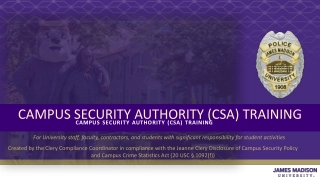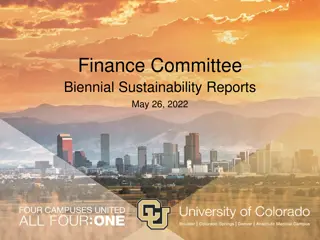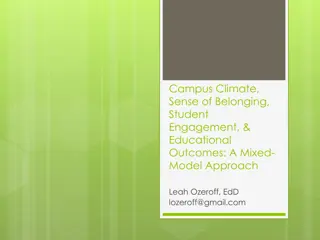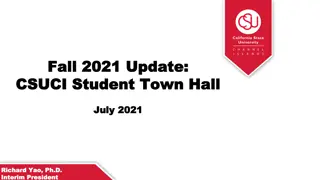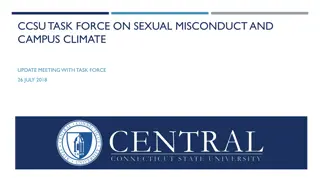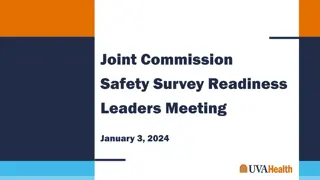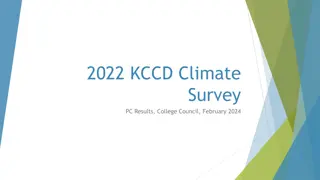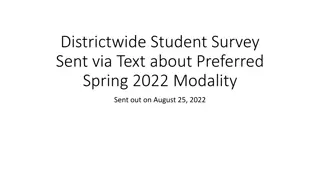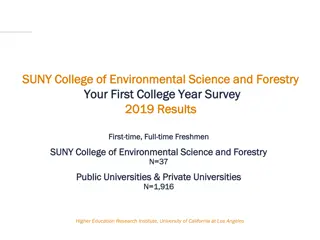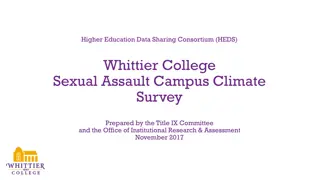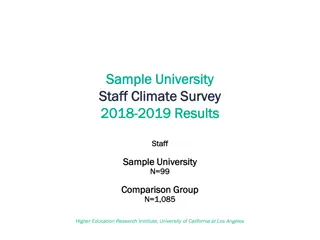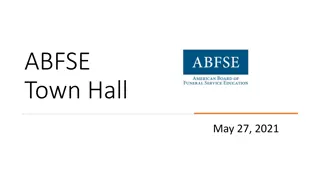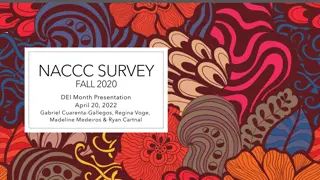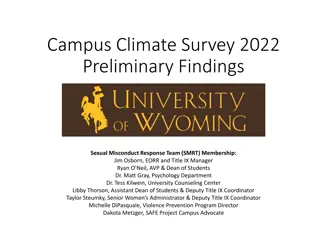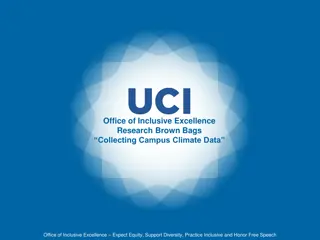Understanding Campus Climate Survey Findings at CSUCI Town Hall
Explore the campus climate survey findings discussed at the CSUCI Town Hall led by Richard Yao, Ph.D., the Interim President. The survey focuses on perceptions of diversity, respect, and behaviors within the campus community, shaping student success and outcomes. Learn about the process, research questions, and next steps for examining and addressing these critical issues on campus.
Download Presentation

Please find below an Image/Link to download the presentation.
The content on the website is provided AS IS for your information and personal use only. It may not be sold, licensed, or shared on other websites without obtaining consent from the author. Download presentation by click this link. If you encounter any issues during the download, it is possible that the publisher has removed the file from their server.
E N D
Presentation Transcript
Campus Climate Survey CSUCI Town Hall May 25, 2021 Richard Yao, Ph.D., Interim President
Campus Climate Defined as: perceptions of members of the campus community related to diversity (Reason & Rankin, 2006) includes attitudes and behaviors related to respect for individuals (Rankin & Reason, 2005) About perceptions, they: form across campus constituency groups (Rankin & Reason, 2005) tend to accumulate over time, so normative standards socially reproduce expectations and actions on campus. Campus climate emerges from: (Hurtado et al, 1998) external factors: public policy, regulatory frameworks, sociohistorical patterns internal factors: exclusionary institutional practices, structural diversity, psychological climate and attitudinal, and behavioral patterns between groups Appears to shape campus experiences and outcomes, including student success, persistence, and completion (Mayhew, 2016)
Purpose Review the process Review high level findings Review findings related to Courageous Conversations Q&A/Discussion: How do we examine context in relation to the findings? Next steps?
Process Build on inaugural Campus Climate Survey in 2018: Higher Education Research Institute University of California Los Angeles 2020 Research Team: Nathan Durdella, Ph.D. Professor and Director of Doctoral Programs in the Department of Educational Leadership & Policy Studies at California State University, Northridge, CA Caroline Q. Durdella, Ph.D. Dean of Institutional Research and Planning at Rio Hondo College in Whittier, CA Jose M. Paez, EdD. Assistant Professor in the Department of Social Work at California State University, Northridge, CA Preeta Saxena, Ph.D. Senior research analyst in the Department of Institutional Research at College of the Canyons in Valencia, CA CI Campus Team
Process Originally planned for Spring 2020 Decision point: Planned October roll-out/HERI delay in release Leadership transitions Data collection: Nov 24 Dec 18, 2020 Review & feedback by Staff Council Exec, Affinity Groups, PACIE, Senate Officers, Student Government: 5/13/2021 Final draft received: 5/19/2021 Survey: HERI: Campus Climate Survey to Staff Climate Survey 2018 v. 2020 modifications
Research Questions What differences are observed between employees based upon the demographic characteristics of race/ethnicity and gender identity? What differences are observed between employees based upon employment designation? What differences are observed between divisions? What differences are observed within divisions? What differences are observed for those employees participating in our Courageous Conversations? What differences are observed among respondents to the 2018 CCS versus the 2020 CCS?
Employee Respondents Included all employees, full- and part-time Faculty: tenure-track and lecturer Staff Administrators Auxiliary services employees 33.9% response rate (351/1034): decrease from 41% in 2018 Qualitative responses: 177 (50% of all respondents) Overrepresented: Women; DSA; managers; tenure-track faculty Under-represented: Men; DAA, DBFA; Latinx, Race unknown; lecturer faculty Analyses: Identity and employee groups with less than 40 survey respondents are included in results as aggregative groups < 10 are not reported in tables
High Level Findings: 2018 v. 2020 Improvement: Participation in PD for diversity (58.4% v. 71.5%) and technical skills (49.7% v. 64.3%) Participation in coalitions to address social justice (24.4% v. 36.5%) Perception that administrators regularly speak out about the value of diversity (51.3% v. 61.9%)
High Level Findings: 2018 v. 2020 Decreases: Climate and Commitment to Diversity Satisfaction with collegiality (54.3% v. 40.8%) Sense of community (63.6% v. 50.8%) Racial/ethnic diversity of faculty (50% v. 30%) Racial/ethnic diversity of staff (60.4% v. 47.8%) Racial/ethnic diversity of students (70.8% v. 52%) Atmosphere for sexual orientation (72.5% v. 54.6%) Atmosphere for political differences (55.8% v. 40.9%) Atmosphere for gender differences (67.7% v. 52.1%) Atmosphere for individuals with disabilities (70.1% v. 46.9%)
High Level Findings: 2018 v. 2020 Decreases: Administrative Response Timeliness of response to emergencies (59.7% v. 49.1%) Timeliness of response to discrimination (45.6% v. 30.1%) Timeliness of response to sexual assault (61.7% v. 37.7%) Outcome of response to emergencies (56.7% v. 46.5%) Outcome of response to discrimination (44.5% v. 38.6%) Outcome of response to sexual assault (56.6% v. 35.5%)
High Level Findings: 2018 v. 2020 Salary satisfaction (40.9% v. 31.8%) Sources of stress budget and workload Stress associated with budget cuts (56.1% v. 79.4%) Increasing work responsibilities (75% of all respondents) TT faculty 89% Managers 89% Staff 64%
High Level Findings: Group Differences Discrimination as a source of stress: 69% not at all Latinx: 37% reported experiences Multiracial: 46% reported experiences Institutional priorities: consideration of faculty in decision making Faculty perceived consideration of their voice in decision making as a lower priority than other groups Also true across divisions AA perceived consideration of faculty voice in decision making as a lower priority than other divisions.
High Level Findings: Group Differences Feeling valued/working conditions: TT faculty lowest ratings Sources of stress personal: TT faculty more likely to report household responsibilities and lack of personal time as a source of stress Sources of stress physical: significantly higher for Latinx and multi-racial Sources of stress organizational: TT faculty more likely to report meetings as a source of stress *Other between and within group differences in report
High Level Findings: Qualitative Racialized forms of discrimination on campus: color blindness, racial tension, racial microaggressions, white privilege as institutional norm Gender microaggressions and sexist comments 2020: transphobia, homophobia, xenophobia, ableism, ageism, anti-Semitism or insensitivity to people of Jewish faith. Questioning campus initiatives promoting DEI 2020: those without dependent children feel dismissed/ignored compared to those with children
High Level Findings: Qualitative 2018/2020 Sense of community: healthy for some, declining for others Institutional hierarchy: staff and lecturers second class citizens Campus leadership: detrimental effects of lack of stable leadership HR concerns COVID mixed reviews Communication/response Remote work: more productivity and savings
Student Survey: Diverse Learning Experiences Full- and part-time, undergraduate and graduate (stateside and EU) Sent to 7,435 students 1,172 respondents 15.76% response rate (2.47% in 2018) note: according to the research team, a 10% response rate for this type of student survey is typical Relatively good representative sample with some exceptions: Overrepresented: Women; Multiracial Under-represented: Men; Latinx Top 5 majors represented: Psychology, Nursing, Biology, Elementary Education, Sociology (compared to most populous 5 majors of Psychology, Biology, Sociology, Business, Health Science)
Student Survey: Diverse Learning Experiences Positive classroom experiences; most but not all instructors as creating a positive classroom environment; faculty validate them often. Highest ratings for Hispanic/Latinx students Lowest for those identifying as a category other than the largest race categories Positive COVID response: campus services, instructor flexibility, leadership response, but high levels of stress Positive commitment to diversity 5.2% experienced unwanted sexual contact or behavior while at CI 4% reported being a victim of sexual assault or attempted sexual assault while at CI
Student Survey: Diverse Learning Experiences Campus satisfaction and opinions related to race/ethnicity, gender identity, and diversity, discrimination and harassment: Positive range on all 5 scales But differences by race/ethnicity; gender identity and disability status All trended towards satisfaction, with exception of those identifying as transgender and students identifying as race/ethnicity other than the largest categories. Civic engagement: students seldom participate in activities related to civic engagement 36% have considered dropping out from CI
Reflections/Next Steps Response rate was disappointing More proactive conversations within divisions prior to roll-out to address questions/concerns. Courageous Conversations: Positive remarks/scores regarding bringing groups across campus together, but critical feedback regarding impact/actions. Moving forward: immediate needs and preparation for 2022 Campus conversations: PACIE/IEAT 4 Breadth v. depth? Additional comparisons/analyses IEAP work


